Barcelona is located on the northeast coast of the Mediterranean Sea and is one of the most important cities of Spain with Madrid.
Barcelona has a prominent role in the culture and politics of Spain, a fact that can be demonstrated to admire the different types of buildings and landmarks.
From Sants Station is a new direct connection from Barcelona to Paris by TGV , the duration is only 6 hours. And with the Ave Barcelona to Madrid in just 2 hours. There are no excuses to visit Barcelona and stay at the Apart- Suites Hostemplo.
The languages spoken are officially Castilian and Catalan, but because of its rich history and for being a truly cosmopolitan city can recognize other languages in different parts of the city like English, French, Portuguese, Italian.
Depending on the season, Barcelona offers several options for those who visit, the weather never becomes extreme, always leaving the opportunity to enjoy the city.
Discover the hidden corners and the best curiosities of Barcelona
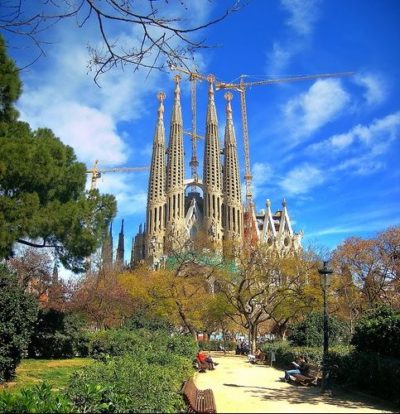 The Sagrada Familia is the most popular and representative monument of Barcelona. It is the main index for modernist architecture created by Gaudi and it has been converted into the symbol of Barcelona. A visit there is essential. Although it is still not finished, the Sagrada Familia is an exuberant temple loaded with religious symbolism. Its construction started in 1882 and, since its inception, the Sagrada Familia has been an expiatory temple, i.e., built from donations. Gaudi died in 1926, leaving the project unfinished, but thanks to the conserved plans, his dream seems like it could finally be realized in 2026 thanks to the work of other artists and the money obtained from donations and visits. To design the interior, Gaudi was inspired by natural forms and he thought tree trunk shaped columns would convert the interior of the temple into an enormous stone forest.
The Sagrada Familia is the most popular and representative monument of Barcelona. It is the main index for modernist architecture created by Gaudi and it has been converted into the symbol of Barcelona. A visit there is essential. Although it is still not finished, the Sagrada Familia is an exuberant temple loaded with religious symbolism. Its construction started in 1882 and, since its inception, the Sagrada Familia has been an expiatory temple, i.e., built from donations. Gaudi died in 1926, leaving the project unfinished, but thanks to the conserved plans, his dream seems like it could finally be realized in 2026 thanks to the work of other artists and the money obtained from donations and visits. To design the interior, Gaudi was inspired by natural forms and he thought tree trunk shaped columns would convert the interior of the temple into an enormous stone forest.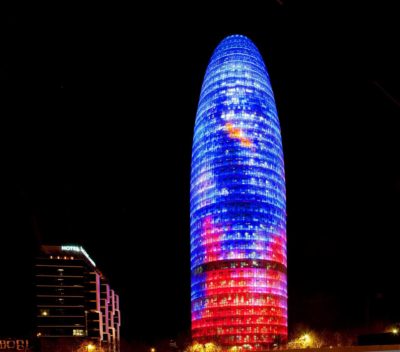 The Agbar Tower is one of the most famous skyscrapers in Barcelona; it is the third tallest after the Arts Hotel and the Mapfre Tower. It is located by the Glories Plaça and the Els Encants market and is one of the representative symbols of the Barcelona skyline. The most significant characteristic of this tower is the 34 floors and its 145 meter height along with its lighting. It has more than 4500 LED lights that project different forms and drawings while they change colors. Because of its characteristics, it is easy to see from various points in Barcelona and has become one of the iconic tourist locations. Without a doubt, the best time to visit it is in the evening, when the façade is full of color. The tower belongs to Aguas de Barcelona (hence the name, Agbar), and was designed by the architect Jean Nouvel, who was inspired by the rounded shape of the mountains at Montserrat and the bell tower at Antoni Gaudi’s Sagrada Familia.
The Agbar Tower is one of the most famous skyscrapers in Barcelona; it is the third tallest after the Arts Hotel and the Mapfre Tower. It is located by the Glories Plaça and the Els Encants market and is one of the representative symbols of the Barcelona skyline. The most significant characteristic of this tower is the 34 floors and its 145 meter height along with its lighting. It has more than 4500 LED lights that project different forms and drawings while they change colors. Because of its characteristics, it is easy to see from various points in Barcelona and has become one of the iconic tourist locations. Without a doubt, the best time to visit it is in the evening, when the façade is full of color. The tower belongs to Aguas de Barcelona (hence the name, Agbar), and was designed by the architect Jean Nouvel, who was inspired by the rounded shape of the mountains at Montserrat and the bell tower at Antoni Gaudi’s Sagrada Familia.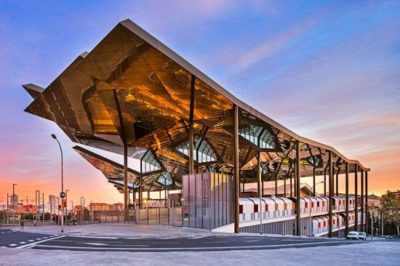 In existence for more than seven centuries, this is one of oldest active markets in Europe. The commercial dynamic of Barcelona is reflected in the Els Encants Market. For a large part of its history it has occupied different places with a true provisional air until 2013 when it opened the doors to an actual and definite location, between Meridiana and Glories Plaça. The market consists of a spectacular 24-meter cover, full of mirrors that reflect of the market’s activities, while also being an architectural jewel. Thanks to this, the market conserves its essence and retrieves the feeling of shopping in the open air while being sheltered from the rain. The best part of the market is the stops and auctions (where from 7 to 9 in the morning auctions for apartments, shops, and stocks are held). “Els Encants” receives 150,000 visitors every week. It is with no doubt one of the best places to buy items that are less common, old or new at an unbeatable price.
In existence for more than seven centuries, this is one of oldest active markets in Europe. The commercial dynamic of Barcelona is reflected in the Els Encants Market. For a large part of its history it has occupied different places with a true provisional air until 2013 when it opened the doors to an actual and definite location, between Meridiana and Glories Plaça. The market consists of a spectacular 24-meter cover, full of mirrors that reflect of the market’s activities, while also being an architectural jewel. Thanks to this, the market conserves its essence and retrieves the feeling of shopping in the open air while being sheltered from the rain. The best part of the market is the stops and auctions (where from 7 to 9 in the morning auctions for apartments, shops, and stocks are held). “Els Encants” receives 150,000 visitors every week. It is with no doubt one of the best places to buy items that are less common, old or new at an unbeatable price. The Ciutadella Park was for many years the only park in the city of Barcelona. It was built by Felipe V in the former grounds of the city fortress, in order to dominate it after the War of Succession (18th century). The park was declared object of cultural interests and historical heritage of Spain and is currently one of the biggest parks in the city. Inside its enclosure is the Barcelona Zoo, a striking waterfall composed by group of monuments and the building of the Three Dragons’ Castle (The Zoology Museum). The park stands out with its large, extended garden with ample trees and areas to take a walk as well as a lake and a waterfall. The lake consists of various small islets and a wide variety of exotic plants, marine animals, where boats can be rented. Next to the waterfall we can find the Romantic Garden, with a large variety of plants. And in the old parade ground there is an oval pond with Josep Llimona’s popular sculpture: Distress.
The Ciutadella Park was for many years the only park in the city of Barcelona. It was built by Felipe V in the former grounds of the city fortress, in order to dominate it after the War of Succession (18th century). The park was declared object of cultural interests and historical heritage of Spain and is currently one of the biggest parks in the city. Inside its enclosure is the Barcelona Zoo, a striking waterfall composed by group of monuments and the building of the Three Dragons’ Castle (The Zoology Museum). The park stands out with its large, extended garden with ample trees and areas to take a walk as well as a lake and a waterfall. The lake consists of various small islets and a wide variety of exotic plants, marine animals, where boats can be rented. Next to the waterfall we can find the Romantic Garden, with a large variety of plants. And in the old parade ground there is an oval pond with Josep Llimona’s popular sculpture: Distress.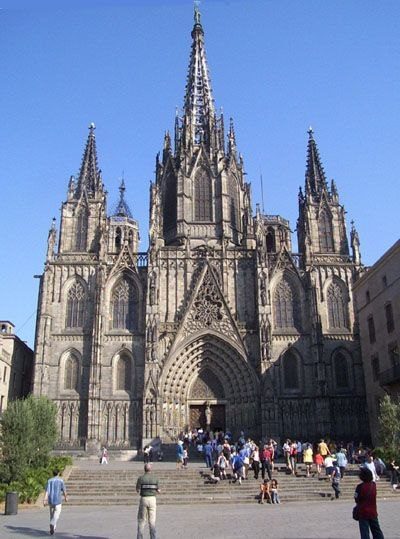 Barcelona’s Cathedral is an example of Gothic Catalonian architecture. Located in the center of the city, it was built during the 14th and 15th centuries on the old Roman cathedral. Originally it was going to be a Romanic style church, but they decided to make it Gothic to attract more tourists at that time. The cathedral is also known as the Santa Cruz (Saint Cross) and Santa Eulalia (Saint Eulalia) Cathedral, because in the tomb of Eulalia, a girl that was tortured to death for defending her Christian faith (340 A.D.), lies in its crypt. 13 geese live in the cloister, and they recall the time when Santa Eulalia died. The choir of the cathedral is one of the most valuable sites inside and it boasts spectacular carved wooden choir stalls. There are two other places of interest: the terrace where one can enjoy views of the city and the chapel of Santo Cristo de Lepanto (Saint Christ of Lepanto) where there is a crucified Christ to which the people of Barcelona have a special devotion.
Barcelona’s Cathedral is an example of Gothic Catalonian architecture. Located in the center of the city, it was built during the 14th and 15th centuries on the old Roman cathedral. Originally it was going to be a Romanic style church, but they decided to make it Gothic to attract more tourists at that time. The cathedral is also known as the Santa Cruz (Saint Cross) and Santa Eulalia (Saint Eulalia) Cathedral, because in the tomb of Eulalia, a girl that was tortured to death for defending her Christian faith (340 A.D.), lies in its crypt. 13 geese live in the cloister, and they recall the time when Santa Eulalia died. The choir of the cathedral is one of the most valuable sites inside and it boasts spectacular carved wooden choir stalls. There are two other places of interest: the terrace where one can enjoy views of the city and the chapel of Santo Cristo de Lepanto (Saint Christ of Lepanto) where there is a crucified Christ to which the people of Barcelona have a special devotion.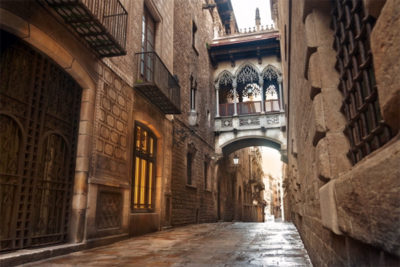 The Gothic Neighborhood belongs to the “Ciutat Vella” district and is the oldest center of Barcelona in addition to being its historic center. The majority of Gothic buildings are concentrated in this neighborhood. The church of Santa María del Mar (Holy Mary of the Sea) or the Church of Santa María del Pino (Holy Mary of the Pine) stand out in the area, but there are many others: the Santa Cruz (Saint Cross) Cathedral, the Merced Basilica, Sant Jaume (Saint James) Square, Plaça Reial (Royal Square), or Portal de l’Angel (the Angel’s Portal). With its charm and historical importance, many cultural routes are organized to describe the secrets of Barcelona’s Gothic, which experienced many changes from the 19th century, like the transformation of cemeteries in public squares or the demolition of the old city wall. Currently, parts of the first wall are preserved in the Square, in front of Barcelona’s Cathedral.
The Gothic Neighborhood belongs to the “Ciutat Vella” district and is the oldest center of Barcelona in addition to being its historic center. The majority of Gothic buildings are concentrated in this neighborhood. The church of Santa María del Mar (Holy Mary of the Sea) or the Church of Santa María del Pino (Holy Mary of the Pine) stand out in the area, but there are many others: the Santa Cruz (Saint Cross) Cathedral, the Merced Basilica, Sant Jaume (Saint James) Square, Plaça Reial (Royal Square), or Portal de l’Angel (the Angel’s Portal). With its charm and historical importance, many cultural routes are organized to describe the secrets of Barcelona’s Gothic, which experienced many changes from the 19th century, like the transformation of cemeteries in public squares or the demolition of the old city wall. Currently, parts of the first wall are preserved in the Square, in front of Barcelona’s Cathedral.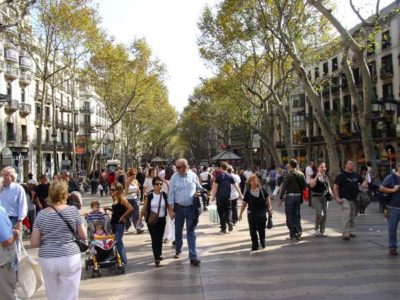 Las Ramblas is the most symbolic promenade in Barcelona. It starts at Cataluña Square and the street flows until the port, where it reaches the Christopher Columbus statue. Las Ramblas consists of diverse sections, hence its name being plural. La Rambla of the Flowers stands out along with La Rambla of Canaletas, with the famous fountain where FC Barcelona celebrates their victories. In addition to flower stands there are kiosks, souvenir shops, and an artisan flea market as well as numerous bars and terraces. In Las Ramblas there are a multitude of artists like living statues, musicians, dancers and cartoonists of all types. If you want an instant portrait, this is the right place! Walking along them one can see various interesting buildings like the famous Boquería market and the Liceo Theatre. The tile design imitating the waves of the ocean is particularly remarkable, together with the magnificent work of artist Joan Miró, halfway down, symbolizing the entry to Barcelona by sea.
Las Ramblas is the most symbolic promenade in Barcelona. It starts at Cataluña Square and the street flows until the port, where it reaches the Christopher Columbus statue. Las Ramblas consists of diverse sections, hence its name being plural. La Rambla of the Flowers stands out along with La Rambla of Canaletas, with the famous fountain where FC Barcelona celebrates their victories. In addition to flower stands there are kiosks, souvenir shops, and an artisan flea market as well as numerous bars and terraces. In Las Ramblas there are a multitude of artists like living statues, musicians, dancers and cartoonists of all types. If you want an instant portrait, this is the right place! Walking along them one can see various interesting buildings like the famous Boquería market and the Liceo Theatre. The tile design imitating the waves of the ocean is particularly remarkable, together with the magnificent work of artist Joan Miró, halfway down, symbolizing the entry to Barcelona by sea.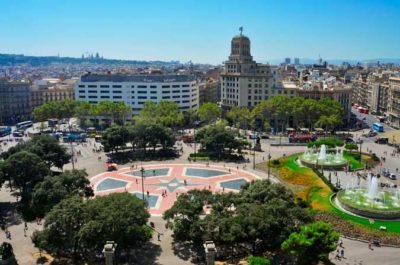 The Cataluña Square is the best known and central in the city. With its five hectares surface, it is one of largest squares in Spain. In the square there are diverse sculptures like The Goddess, Barcelona, The Shepherd, or the most well known, Fransesc Macià of Subirachs which is formed by a pedestal that represents the history of Catalonia and an inverted and unfinished ladder (which symbolizes the future of the country, step by step, rung by rung). Also, there are various decorative works from important artists like Josep Llimona or Enrique Casanovas. Due to its great location, the square serves as a link between L’Eixample and the older center of the city. The most important routes of Barcelona depart from here: Las Ramblas, Paseo de Gracia, Ronda de Sant Pere, Pelayo street…. The surrounding area gathers a powerful economic and commercial activity: hotels, restaurants, stores or malls enliven daytime life in the square.
The Cataluña Square is the best known and central in the city. With its five hectares surface, it is one of largest squares in Spain. In the square there are diverse sculptures like The Goddess, Barcelona, The Shepherd, or the most well known, Fransesc Macià of Subirachs which is formed by a pedestal that represents the history of Catalonia and an inverted and unfinished ladder (which symbolizes the future of the country, step by step, rung by rung). Also, there are various decorative works from important artists like Josep Llimona or Enrique Casanovas. Due to its great location, the square serves as a link between L’Eixample and the older center of the city. The most important routes of Barcelona depart from here: Las Ramblas, Paseo de Gracia, Ronda de Sant Pere, Pelayo street…. The surrounding area gathers a powerful economic and commercial activity: hotels, restaurants, stores or malls enliven daytime life in the square.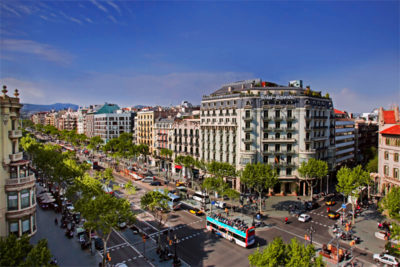 The Passeig de Gracia is one of most spacious and prestigious avenues in Barcelona. It connects the Diagonal with Cataluña Square. It is full of magnificent buildings, because in the heyday of the economy, the Catalonian bourgeoisie competed to possess the most beautiful house in the area, having the three fashionable architects of the time build them: Gaudi, Cadafalch & Domench and Muntaner. There is even a block with the works of all three called the Block of the Concorde. From all the magnificent constructions, the Batlló house and La Pedrera stand out in the area. The Batlló family house has become one of the most famous works of Gaudi and, along with La Pedrera, can be visited. In addition to the must see architecture, the Passeig de Gracia is one of the most exclusive and luxurious shopping strips in the country and has a multitude of high-end boutiques and hotels.
The Passeig de Gracia is one of most spacious and prestigious avenues in Barcelona. It connects the Diagonal with Cataluña Square. It is full of magnificent buildings, because in the heyday of the economy, the Catalonian bourgeoisie competed to possess the most beautiful house in the area, having the three fashionable architects of the time build them: Gaudi, Cadafalch & Domench and Muntaner. There is even a block with the works of all three called the Block of the Concorde. From all the magnificent constructions, the Batlló house and La Pedrera stand out in the area. The Batlló family house has become one of the most famous works of Gaudi and, along with La Pedrera, can be visited. In addition to the must see architecture, the Passeig de Gracia is one of the most exclusive and luxurious shopping strips in the country and has a multitude of high-end boutiques and hotels. The Milà House (a.k.a. La Pedrera) shows Gaudi’s artistic completeness. This work belongs to his naturalistic stage and is his second most important house. The Milà family, following the Batlló family’s advice, had Gaudi construct the house. This time, he was inspired by the shape of a quarry (“pedrera” in Catalan, hence its alias) and ocean waves. Built from 1906-1912, this spectacular building is one of the most visited places in Barcelona and was declared World Heritage by Unesco in 1984. Despite its dimensions, it occupies an entire chamfer, its winding form and its play of light gives the feeling of being in motion. Like his other works, natural shapes inspired Gaudi. Gaudi usually used Catalonian materials; however, for this house he used limestone for the façade and covered the top with white tiles, simulating a snow-covered mountain. On the roof terrace, there are large staircases topped with the four-arm Gaudi’s cross as well as fireplaces covered with pottery pieces, giving the appearance that they are warrior heads.
The Milà House (a.k.a. La Pedrera) shows Gaudi’s artistic completeness. This work belongs to his naturalistic stage and is his second most important house. The Milà family, following the Batlló family’s advice, had Gaudi construct the house. This time, he was inspired by the shape of a quarry (“pedrera” in Catalan, hence its alias) and ocean waves. Built from 1906-1912, this spectacular building is one of the most visited places in Barcelona and was declared World Heritage by Unesco in 1984. Despite its dimensions, it occupies an entire chamfer, its winding form and its play of light gives the feeling of being in motion. Like his other works, natural shapes inspired Gaudi. Gaudi usually used Catalonian materials; however, for this house he used limestone for the façade and covered the top with white tiles, simulating a snow-covered mountain. On the roof terrace, there are large staircases topped with the four-arm Gaudi’s cross as well as fireplaces covered with pottery pieces, giving the appearance that they are warrior heads.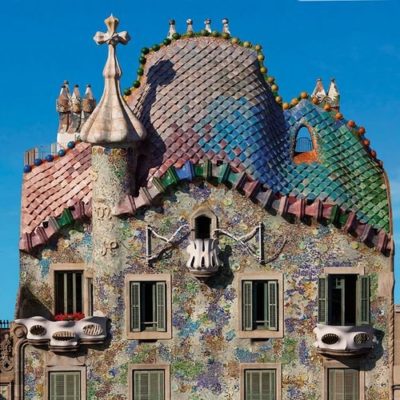 The Batlló House is the most representative work of modernism, along with La Pedrera. It was commissioned to the genius architect Gaudi between 1904 and 1906 by the Batlló family (in this time, the high Catalonian bourgeoisie competed to have the prettiest house). It was opened to the public in 2002 and three years later Unesco declared it World Heritage. In addition to this must-see, during the summer different activities and musical events are held on its terraces. The building symbolizes the mythical Catalonian legend of Saint Jordi: the roof stands out emulating the dragon’s back. The waves of the Mediterranean Sea inspired Gaudi’s design for the façade, while the inside of the house is full of details that emulate the organic forms of nature without losing the functionality of a home.
The Batlló House is the most representative work of modernism, along with La Pedrera. It was commissioned to the genius architect Gaudi between 1904 and 1906 by the Batlló family (in this time, the high Catalonian bourgeoisie competed to have the prettiest house). It was opened to the public in 2002 and three years later Unesco declared it World Heritage. In addition to this must-see, during the summer different activities and musical events are held on its terraces. The building symbolizes the mythical Catalonian legend of Saint Jordi: the roof stands out emulating the dragon’s back. The waves of the Mediterranean Sea inspired Gaudi’s design for the façade, while the inside of the house is full of details that emulate the organic forms of nature without losing the functionality of a home.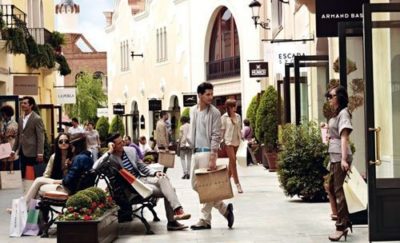 La Roca Village is an outlet shopping area located at the outskirts of Barcelona. It is perfect for buying high-end clothes at a more economical price. Brands like Ralph Lauren, Armani, Custo, Escada… all have outlet stores here. Also, the mall is like a small village with houses, all outdoors, which is ideal for buying at a good price or to have a snack in one of the many restaurants. It is open everyday from 10am-9pm, there is free Wi-Fi, there are various ATMs for taking out cash without a problem and there is free outdoor parking. They have even thought about pets and they have created a free space so they can run and play outside, being with complete calm and certainty that they are perfectly treated.
La Roca Village is an outlet shopping area located at the outskirts of Barcelona. It is perfect for buying high-end clothes at a more economical price. Brands like Ralph Lauren, Armani, Custo, Escada… all have outlet stores here. Also, the mall is like a small village with houses, all outdoors, which is ideal for buying at a good price or to have a snack in one of the many restaurants. It is open everyday from 10am-9pm, there is free Wi-Fi, there are various ATMs for taking out cash without a problem and there is free outdoor parking. They have even thought about pets and they have created a free space so they can run and play outside, being with complete calm and certainty that they are perfectly treated.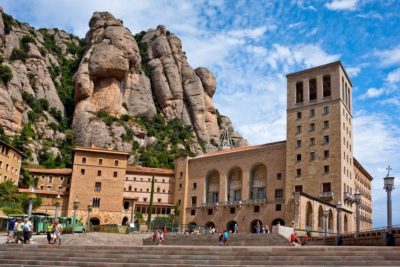 Montserrat is a rock mass considered to be the most important mountain in Catalonia. Located 50 kilometers away from Barcelona, it is known for its particular morphology (it seems like it has been serrated) and for its monastery, point of pilgrimage for religious individuals and a must visit for tourists. The complex consists of the Santa María (Holy Mary) Monastery of Montserrat, the basilica, and the museum. It is a benedict monastery founded in the 6th century, located 720 meters above sea level. Here one can find the Virgin of Montserrat, commonly known as La Moreneta, patron saint of Catalonia, peculiar due to the black color of her face and famous for her miracles and wonders. The sanctuary of Montserrat contains numerous demonstrations of the architectural and sculpture work of internationally renowned artists. In the museum one can view works from Dalí, El Greco, Miró, Picasso, Tapies, etc. Montserrat also is known for its choirboys, one of the oldest in Europe.
Montserrat is a rock mass considered to be the most important mountain in Catalonia. Located 50 kilometers away from Barcelona, it is known for its particular morphology (it seems like it has been serrated) and for its monastery, point of pilgrimage for religious individuals and a must visit for tourists. The complex consists of the Santa María (Holy Mary) Monastery of Montserrat, the basilica, and the museum. It is a benedict monastery founded in the 6th century, located 720 meters above sea level. Here one can find the Virgin of Montserrat, commonly known as La Moreneta, patron saint of Catalonia, peculiar due to the black color of her face and famous for her miracles and wonders. The sanctuary of Montserrat contains numerous demonstrations of the architectural and sculpture work of internationally renowned artists. In the museum one can view works from Dalí, El Greco, Miró, Picasso, Tapies, etc. Montserrat also is known for its choirboys, one of the oldest in Europe. The Dalí Theater-Museum is a museum dedicated entirely to the painter Salvador Dalí, located in the Gala-Salvador Dalí Plaza in Figueres. This is managed by his Foundation and it is where the majority of the artist’s work can be found, along with the Reina Sofia Museum in Madrid. Dalí personally commissioned the project, which included the reconstruction of the building that had been a neoclassic construction. Inside the museum one can find Dalí’s last living space and a crypt with his tomb. Dalí was buried here against his will, because he wanted to be buried in Púbol Castle with his wife, Gala. The museum has different environments, as each space is a work of art containing peculiar paintings, sculptures, furniture, decorations, and every type of curious items. In many of the stays, stands and ceilings are covered with enormous murals with enlarged pictures from Dalí.
The Dalí Theater-Museum is a museum dedicated entirely to the painter Salvador Dalí, located in the Gala-Salvador Dalí Plaza in Figueres. This is managed by his Foundation and it is where the majority of the artist’s work can be found, along with the Reina Sofia Museum in Madrid. Dalí personally commissioned the project, which included the reconstruction of the building that had been a neoclassic construction. Inside the museum one can find Dalí’s last living space and a crypt with his tomb. Dalí was buried here against his will, because he wanted to be buried in Púbol Castle with his wife, Gala. The museum has different environments, as each space is a work of art containing peculiar paintings, sculptures, furniture, decorations, and every type of curious items. In many of the stays, stands and ceilings are covered with enormous murals with enlarged pictures from Dalí.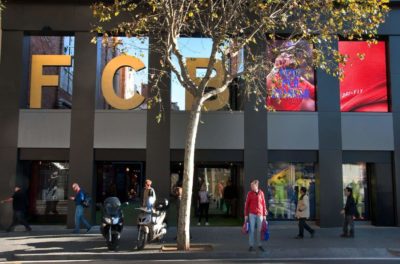 Near the Sagrada Familia, soccer fans and any Barça supporters will be able to visit the F.C. Barcelona Museum store where, in addition to reliving the greatest moments in the team’s history, one can buy a jersey of one of their idols: Messi, Neymar Jr., Luis Suarez, Iniesta…
Near the Sagrada Familia, soccer fans and any Barça supporters will be able to visit the F.C. Barcelona Museum store where, in addition to reliving the greatest moments in the team’s history, one can buy a jersey of one of their idols: Messi, Neymar Jr., Luis Suarez, Iniesta…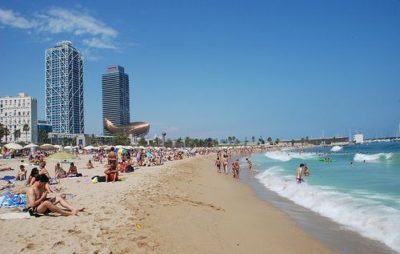 The Barceloneta beach is the most popular beach in Barcelona (and also the oldest one). It is in the Barceloneta neighborhood, hence its name, and together with the beaches next to it, it is one of the largest beaches. Due to its good location, near the Barceloneta and Ciutadella metro stops, it is one of the preferred beaches by tourists. It has many facilities to play sports from sand volleyball to paddle boarding and it also includes a nude area. The beaches of Barcelona are ideal for taking a dip, sunbathing, walking along the shore or enjoying eating good paella overlooking the sea, and this is all only 10 minutes from the center of Barcelona.
The Barceloneta beach is the most popular beach in Barcelona (and also the oldest one). It is in the Barceloneta neighborhood, hence its name, and together with the beaches next to it, it is one of the largest beaches. Due to its good location, near the Barceloneta and Ciutadella metro stops, it is one of the preferred beaches by tourists. It has many facilities to play sports from sand volleyball to paddle boarding and it also includes a nude area. The beaches of Barcelona are ideal for taking a dip, sunbathing, walking along the shore or enjoying eating good paella overlooking the sea, and this is all only 10 minutes from the center of Barcelona. The Picasso Museum of Barcelona, located in El Born, is of national interest and possesses a collection of 4249 of the painter’s works, which have become the world’s most complete group of the work of young Picasso. The collection of works is based on the years of Picasso’s training practically until the painter’s blue period. In addition to this, the museum also has a large representation of works from 1917 and the series The Meninas as well a complete collection of prints. The Picasso museum occupies five large mansions and palaces on Montcada Street, which dates back to the 18th and 19th century but has been remodeled over time for conservation. The palaces are a great demonstration of the Catalonian civil Gothic art with a common structure; the vast majority are around a courtyard and an access to the main floor using a bare, exterior staircase.
The Picasso Museum of Barcelona, located in El Born, is of national interest and possesses a collection of 4249 of the painter’s works, which have become the world’s most complete group of the work of young Picasso. The collection of works is based on the years of Picasso’s training practically until the painter’s blue period. In addition to this, the museum also has a large representation of works from 1917 and the series The Meninas as well a complete collection of prints. The Picasso museum occupies five large mansions and palaces on Montcada Street, which dates back to the 18th and 19th century but has been remodeled over time for conservation. The palaces are a great demonstration of the Catalonian civil Gothic art with a common structure; the vast majority are around a courtyard and an access to the main floor using a bare, exterior staircase.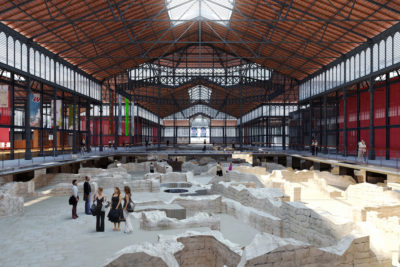 El Born is the most artistic and trendy district of the city. It is full of narrow streets with noteworthy modern and medieval contrasts. It lies between Via Laietana and Barceloneta bordering Ciutadella Park. During Middle Age, this area commonly held joustings and executions. However, the area became wealthier thanks to the commercial routes of the time. Do not miss the church of Santa María del Mar (Holy Mary of the Sea), Picasso Museum, and the Textile Museum, of great cultural interest, as well as the Born Market, where archeological remains from the Middle Age were discovered during remodeling. During the day you can get lost in the streets and discover the wide variety of artist and design shops, or take a break in one of the many cafes. At night, the Passeig del Born offers a great variety of bars and tapas places that are open late into the night.
El Born is the most artistic and trendy district of the city. It is full of narrow streets with noteworthy modern and medieval contrasts. It lies between Via Laietana and Barceloneta bordering Ciutadella Park. During Middle Age, this area commonly held joustings and executions. However, the area became wealthier thanks to the commercial routes of the time. Do not miss the church of Santa María del Mar (Holy Mary of the Sea), Picasso Museum, and the Textile Museum, of great cultural interest, as well as the Born Market, where archeological remains from the Middle Age were discovered during remodeling. During the day you can get lost in the streets and discover the wide variety of artist and design shops, or take a break in one of the many cafes. At night, the Passeig del Born offers a great variety of bars and tapas places that are open late into the night.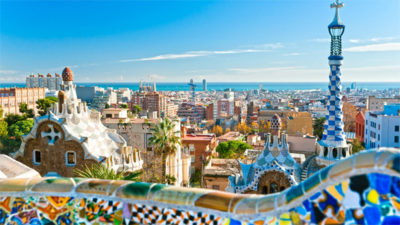 The Parc Güell is the emblematic park of Catalan modernism. Located in the most elevated part of Barcelona, Mount Carmelo, it is an essential place to visit. Antoni Gaudi, commissioned by entrepreneur Eusebi Güell, designed a park with large garden areas, full of paths that invite relaxation and calm. The architect constructed the park consistent with his more naturalistic stage of modernism, inspired by the organic shapes of nature. It has a rococo touch with elaborate, colorful ceramic sculptures. Between all the works “El Drac” clearly stands out and has now become an icon of the city. It is a park full of charm and was declared World Heritage by Unesco from among the works of Gaudi. It is a perfect place to walk peacefully and admire all of the genius of the Catalonian architect.
The Parc Güell is the emblematic park of Catalan modernism. Located in the most elevated part of Barcelona, Mount Carmelo, it is an essential place to visit. Antoni Gaudi, commissioned by entrepreneur Eusebi Güell, designed a park with large garden areas, full of paths that invite relaxation and calm. The architect constructed the park consistent with his more naturalistic stage of modernism, inspired by the organic shapes of nature. It has a rococo touch with elaborate, colorful ceramic sculptures. Between all the works “El Drac” clearly stands out and has now become an icon of the city. It is a park full of charm and was declared World Heritage by Unesco from among the works of Gaudi. It is a perfect place to walk peacefully and admire all of the genius of the Catalonian architect.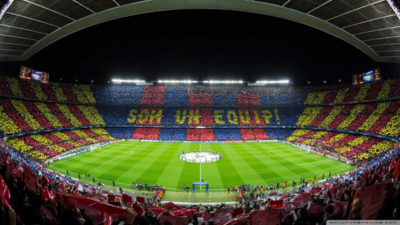 Camp Nou is the stadium of the famous Fútbol Club Barcelona, Barça, one of the two teams from the city in the top division. The stadium is situated in Les Corts neighborhood, along the Diagonal. It opened in 1957 and is the sports stadium with the greatest capacity in Europe, and 5th in world, with a capacity of almost 100,000 people. On February 13th, 1998, UEFA awarded Camp Nou the elite stadium rating, becoming the second in Spain to receive this distinction. In addition to being able to see the best soccer players in the world play on a spectacular field, the sports complex also has an ice skating rink, various stores and restaurants and the Barça museum, where all of the trophies are on display as well as history about the Club.
Camp Nou is the stadium of the famous Fútbol Club Barcelona, Barça, one of the two teams from the city in the top division. The stadium is situated in Les Corts neighborhood, along the Diagonal. It opened in 1957 and is the sports stadium with the greatest capacity in Europe, and 5th in world, with a capacity of almost 100,000 people. On February 13th, 1998, UEFA awarded Camp Nou the elite stadium rating, becoming the second in Spain to receive this distinction. In addition to being able to see the best soccer players in the world play on a spectacular field, the sports complex also has an ice skating rink, various stores and restaurants and the Barça museum, where all of the trophies are on display as well as history about the Club. Just one metro stop from Passeig de Gracia, the Gracia neighborhood is a place with its own personality, a mix of traditional and modern. It is filled with artists and bohemian crowds that coexist with lifelong neighbors. It also retains great ethnic diversity. Famous artists like el Pescailla, one of the fathers of the Catalan rumba (married to Lola Flores), were born here and contributed to equip the neighborhood with a happy and welcoming character. Gracia boasts a large concentration of bars and terraces. Leaving aside Parc Güell, the most popular part of the area, Gracia has the most well-known neighborhood celebrations in mid-August. The neighbors work during the month to decorate the streets and the most beautiful one wins a prize. The artist decorations are spectacular and are mostly made with recycled material. In addition to enjoying walking through its decorated streets, during the celebrations there are concerts and other leisure activities.
Just one metro stop from Passeig de Gracia, the Gracia neighborhood is a place with its own personality, a mix of traditional and modern. It is filled with artists and bohemian crowds that coexist with lifelong neighbors. It also retains great ethnic diversity. Famous artists like el Pescailla, one of the fathers of the Catalan rumba (married to Lola Flores), were born here and contributed to equip the neighborhood with a happy and welcoming character. Gracia boasts a large concentration of bars and terraces. Leaving aside Parc Güell, the most popular part of the area, Gracia has the most well-known neighborhood celebrations in mid-August. The neighbors work during the month to decorate the streets and the most beautiful one wins a prize. The artist decorations are spectacular and are mostly made with recycled material. In addition to enjoying walking through its decorated streets, during the celebrations there are concerts and other leisure activities.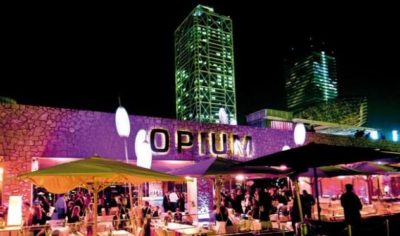 The pub zone of the Olympic Port is an ideal place to grab a few drinks or go to dance to a club. Located next to the Barceloneta Beach, below the twin towers of Barcelona, in Olympic Port there are ample leisurely places for all your wants. The majority of the pubs close at 3am and usually it is free to enter, but the clubs are open until 6am so that the party doesn’t stop. The most chic places in the city are here, between Shoko (Oriental Lounge Club Restaurant), the Catwalk (a very sophisticated club where you can hear the best house music of the time) or Opium (one of the most famous clubs in Spain). There is also Ice Barcelona, an original alternative where one can get a drink and inside an ice bar with an inside temperature of five degrees Celsius. Entry includes a jacket and gloves so that no one gets cold and there is a replica of the Sagrada Familia made out of ice.
The pub zone of the Olympic Port is an ideal place to grab a few drinks or go to dance to a club. Located next to the Barceloneta Beach, below the twin towers of Barcelona, in Olympic Port there are ample leisurely places for all your wants. The majority of the pubs close at 3am and usually it is free to enter, but the clubs are open until 6am so that the party doesn’t stop. The most chic places in the city are here, between Shoko (Oriental Lounge Club Restaurant), the Catwalk (a very sophisticated club where you can hear the best house music of the time) or Opium (one of the most famous clubs in Spain). There is also Ice Barcelona, an original alternative where one can get a drink and inside an ice bar with an inside temperature of five degrees Celsius. Entry includes a jacket and gloves so that no one gets cold and there is a replica of the Sagrada Familia made out of ice. Very close to Hostemplo we find the Skating club ice rink. Doing a different activity can also be a good option. At Skating one can enjoy an ice skating rink to skate and have fun every day of the year (it’s the only one in Barcelona open 365 days!). The facility is very complete and they rent out skates, gloves (required), caps, helmets…and they even organize skating birthday parties! To make the skating more fun, they play disco music in the rink and if one wants to take a break, one can get a hot drink and eat in the restaurant. Skating takes special care of its rink and every certain time they close it in order to clean and repair the ice, so it is always in optimal condition. Ice-skating at Skating is a good alternative to the sun and heat of the beach in Barcelona.
Very close to Hostemplo we find the Skating club ice rink. Doing a different activity can also be a good option. At Skating one can enjoy an ice skating rink to skate and have fun every day of the year (it’s the only one in Barcelona open 365 days!). The facility is very complete and they rent out skates, gloves (required), caps, helmets…and they even organize skating birthday parties! To make the skating more fun, they play disco music in the rink and if one wants to take a break, one can get a hot drink and eat in the restaurant. Skating takes special care of its rink and every certain time they close it in order to clean and repair the ice, so it is always in optimal condition. Ice-skating at Skating is a good alternative to the sun and heat of the beach in Barcelona. The Tibidabo amusment park is a magical and emblematic place of the city of Barcelona. It is located on the Tibidabo Mountain and is one of the oldest amusement parks in the world (it is the oldest one in Spain and third oldest one in Europe). Its privileged location stands out with its marvelous views of Barcelona from 500 meters high. Access to its viewpoints and paths in the middle of the forest are free. Woody Allen chose it shoot some of the scenes in the Academy Award-winning film “Vicky Cristina Barcelona”. With its 70000 square meters, the park is formed into six levels. Levels 1-5 are where the majority of the attractions are, while the sixth level has free access and is considered a better garden with attractions for walking. The park has more than 25 attractions suitable for all ages, as well as shows and animated walks that make for an enjoyable day for a family. Don’t miss the Automatons Museum, a historic attraction that is a must see.
The Tibidabo amusment park is a magical and emblematic place of the city of Barcelona. It is located on the Tibidabo Mountain and is one of the oldest amusement parks in the world (it is the oldest one in Spain and third oldest one in Europe). Its privileged location stands out with its marvelous views of Barcelona from 500 meters high. Access to its viewpoints and paths in the middle of the forest are free. Woody Allen chose it shoot some of the scenes in the Academy Award-winning film “Vicky Cristina Barcelona”. With its 70000 square meters, the park is formed into six levels. Levels 1-5 are where the majority of the attractions are, while the sixth level has free access and is considered a better garden with attractions for walking. The park has more than 25 attractions suitable for all ages, as well as shows and animated walks that make for an enjoyable day for a family. Don’t miss the Automatons Museum, a historic attraction that is a must see.